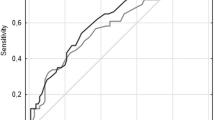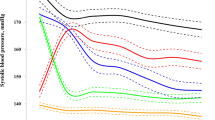Abstract
The relationship between blood pressure variability (BPV) and stroke recurrence is controversial. This study aimed to evaluate the predictive value of short-term and long-term BPV for stroke recurrence. The data from blood pressure and clinical outcome in TIA or ischemic stroke (BOSS) study included participants with acute ischemic stroke or transient ischemic attack (TIA) within 7 days after onset. Short-term BPV was measured by 24-h ambulatory BP measurement during hospitalisation. Long-term BPV, based on home blood pressure measurement, was measured by patients or their families from discharge to 90 days after qualifying events onset (twice daily). Variability for systolic blood pressure (SBP) was assessed as the s.d., coefficients of variance (CV). The clinical outcome was recurrent stroke within 1 year. Cox proportional hazards models were used to test the association of short-term BPV, long-term BPV and stroke recurrence. Among 1764 participants, the mean age was 62.45±10.99 years, and 32.1% were females, during 1-year follow-up, 106 (6.0%) participants experienced recurrent stroke. Indices of long-term BPV were significantly associated with stroke recurrence (s.d.: adjusted HR: 1.939, 95% CI: 1.122–3.351; CV: adjusted HR 1.955, 95% CI: 1.174–3.255), independent of mean SBP. However, all indices of short-term BPV (s.d., CV) were not associated with stroke recurrence (s.d.: adjusted HR: 1.245, 95% CI: 0.680–2.280; CV: adjusted HR: 1.142, 95% CI: 0.640–2.038). In conclusion, long-term variation of SBP is a better predictor than short-term variation of SBP for recurrent stroke after acute ischemic stroke or TIA.
This is a preview of subscription content, access via your institution
Access options
Subscribe to this journal
Receive 12 digital issues and online access to articles
$119.00 per year
only $9.92 per issue
Buy this article
- Purchase on Springer Link
- Instant access to full article PDF
Prices may be subject to local taxes which are calculated during checkout


Similar content being viewed by others
References
Irigoyen MC, De Angelis K, Dos Santos F, Dartora DR, Rodrigues B, Consolim-Colombo FM . Hypertension, blood pressure variability, and target organ Lesion. Curr Hypertens Rep 2016; 18: 31.
Taylor KS, Heneghan CJ, Stevens RJ, Adams EC, Nunan D, Ward A . Heterogeneity of prognostic studies of 24-hour blood pressure variability: systematic review and meta-analysis. PLoS ONE 2015; 10: e0126375.
Parati G, Ochoa JE, Lombardi C, Bilo G . Assessment and management of blood-pressure variability. Nat Rev Cardiol 2013; 10: 143–155.
Parati G, Ochoa JE, Bilo G, Agarwal R, Covic A, Dekker FW et al. Hypertension in chronic kidney disease part 2: role of ambulatory and home blood pressure monitoring for assessing alterations in blood pressure variability and blood pressure profiles. Hypertension 2016; 67: 1102–1110.
Stevens SL, Wood S, Koshiaris C, Law K, Glasziou P, Stevens RJ et al. Blood pressure variability and cardiovascular disease: systematic review and meta-analysis. BMJ 2016; 354: i4098.
ESH/ESC Task Force for the Management of Arterial Hypertension. 2013 Practice guidelines for the management of arterial hypertension of the European Society of Hypertension (ESH) and the European Society of Cardiology (ESC): ESH/ESC Task Force for the Management of Arterial Hypertension. J Hypertens 2013; 31: 1925–1938.
Solak Y, Kario K, Covic A, Bertelsen N, Afsar B, Ozkok A et al. Clinical value of ambulatory blood pressure: Is it time to recommend for all patients with hypertension? Clin Exp Nephrol 2016; 20: 14–22.
Poortvliet IF, Ford I, Lloyd SM, Sattar N, Mooijaart SP, de Craen AJ et al. Blood Pressure variability and cardiovascular risk in the prospective study of pravastatin in the elderly at risk (PROSPER). PLoS ONE 2012; 7: e52438.
ETO M, Kozaki K, Watanabe T, Kim S, Hashimoto M, Ako J et al. Impact of blood pressure variability on cardiovascular events in elderly patients with hypertension. Hypertens Res 2005; 28: 1–7.
Rothwell PM . Limitations of the usual blood-pressure hypothesis and importance of variability, instability, and episodic hypertension. Lancet 2010; 375: 938–948.
Hansen TW, Thijs L, Li Y, Boggia J, Kikuya M, Bjorklund-Bodegard K et al. Prognostic value of reading-to-reading blood pressure variability over 24 hours in 8938 subjects from 11 populations. Hypertension 2010; 55: 1049–1057.
Madden JM, O'Flynn AM, Dolan E, Fitzgerald AP, Kearney PM . Short-term blood pressure variability over 24 h and target organ damage in middle-aged men and women. J Hum Hypertens 2015; 29: 719–725.
Whittle J . Blood pressure variability and cardiovascular risk. BMJ 2016; 354: i4190.
Kikuya M, Ohkubo T, Metoki H, Asayama K, Hara A, Obara T et al. Day-by-day variability of blood pressure and heart rate at home as a novel predictor of prognosis: the Ohasama study. Hypertension 2008; 52: 1045–1050.
Rothwell PM, Howard SC, Dolan E, O’Brien E, Dobson JE, Dahlöf B et al. Prognostic signifi cance of visit-to-visit variability,maximum systolic blood pressure, and episodic hypertension. Lancet 2010; 375: 895–905.
Johansson JK, Niiranen TJ, Puukka PJ, Jula AM . Prognostic value of the variability in home-measured blood pressure and heart rate: the Finn-Home Study. Hypertension 2012; 59: 212–218.
Shimbo D, Newman JD, Aragaki AK, LaMonte MJ, Bavry AA, Allison M et al. Association between annual visit-to-visit blood pressure variability and stroke in postmenopausal women: data from the Women's Health Initiative. Hypertension 2012; 60: 625–630.
Lau KK, Wong YK, Chang RS, Teo KC, Hon SF, Chan KH et al. Visit-to-visit systolic blood pressure variability predicts all-cause and cardiovascular mortality after lacunar infarct. Eur J Neurol 2014; 21: 319–325.
Muntner P, Shimbo D, Tonelli M, Reynolds K, Arnett DK, Oparil S . The relationship between visit-to-visit variability in systolic blood pressure and all-cause mortality in the general population: findings from NHANES III, 1988 to 1994. Hypertension 2011; 57: 160–166.
Lau KK, Wong YK, Teo KC, Chang RS, Chan KH, Hon SF et al. Long-term prognostic implications of visit-to-visit blood pressure variability in patients with ischemic stroke. Am J Hypertens 2014; 27: 1486–1494.
Sharman JE, Howes FS, Head GA, McGrath BP, Stowasser M, Schlaich M et al. Home blood pressure monitoring: Australian Expert Consensus Statement. J Hypertens 2015; 33: 1721–1728.
Fukuda K, Kai H, Kamouchi M, Hata J, Ago T, Nakane H et al. Day-by-day blood pressure variability and functional outcome after acute ischemic stroke. Stroke 2015; 46: 1832–1839.
Kang J, Ko Y, Park JH, Kim WJ, Jang MS, Yang MH et al. Effect of blood pressure on 3-month functional outcome in the subacute stage of ischemic stroke. Neurology 2012; 79: 2018–2024.
Xu J, Liu Y, Tao Y, Xie X, Gu H, Pan Y et al. The design, rationale, and baseline characteristics of a nationwide cohort registry in China: blood pressure and clinical outcome in TIA or ischemic stroke. Patient Prefer Adherence 2016; 10: 2419–2427.
Parati G, Stergiou G, O'Brien E, Asmar R, Beilin L, Bilo G et al. European Society of Hypertension practice guidelines for ambulatory blood pressure monitoring. J Hypertens 2014; 32: 1359–1366.
Parati G, Stergiou GS, Asmac R, Bilo G, de Leeuw P, Imai Y et al. European Society of Hypertension guidelines for blood pressure monitoring at home: a summary report of the Second International Consensus Conference on Home Blood Pressure Monitoring. J Hypertens 2008; 26: 1505–1526.
Rothwell PM, Howard SC, Dolan E, O'Brien E, Dobson JE, Dahlof B et al. Prognostic significance of visit-to-visit variability, maximum systolic blood pressure, and episodic hypertension. Lancet 2010; 375: 895–905.
Parati G, Ochoa JE, Lombardi C, Bilo G . Blood pressure variability: assessment, predictive value, and potential as a therapeutic target. Curr Hypertens Rep 2015; 17: 537.
Tomii Y, Toyoda K, Suzuki R, Naganuma M, Fujinami J, Yokota C et al. Effects of 24-hour blood pressure and heart rate recorded with ambulatory blood pressure monitoring on recovery from acute ischemic stroke. Stroke 2011; 42: 3511–3517.
Jauch EC, Saver JL, Adams HP Jr, Connors JJ, Demaerschalk BM, Khatri P et al. Guidelines for the early management of patients with acute ischemic stroke. Stroke 2013; 44: 870–947.
Bilo G, Giglio A, Styczkiewicz K, Caldara G, Maronati A, Kawecka-Jaszcz K et al. A new method for assessing 24-h blood pressure variability after excluding the contribution of nocturnal blood pressure fall. J Hypertens 2007; 25: 2058–2066.
Acknowledgements
This study was supported by grants from the Ministry of Science and Technology of the People’s Republic of China (2011BAI08B01 and 2013BAI09B03), and a grant from Beijing Municipal Administration of Hospitals’ Youth Programme (QML2015 0504). This study was also funded by AstraZeneca, which did not participate in the proposal design, implementation and Statistics.
Author information
Authors and Affiliations
Corresponding authors
Ethics declarations
Competing interests
The authors declare no conflict of interest.
Additional information
Supplementary Information accompanies this paper on the Journal of Human Hypertension website
Rights and permissions
About this article
Cite this article
Tao, Y., Xu, J., Song, B. et al. Short-term blood pressure variability and long-term blood pressure variability: which one is a reliable predictor for recurrent stroke. J Hum Hypertens 31, 568–573 (2017). https://doi.org/10.1038/jhh.2017.32
Received:
Revised:
Accepted:
Published:
Issue Date:
DOI: https://doi.org/10.1038/jhh.2017.32



